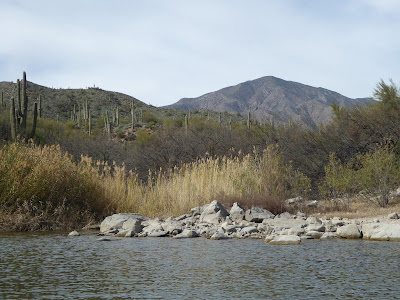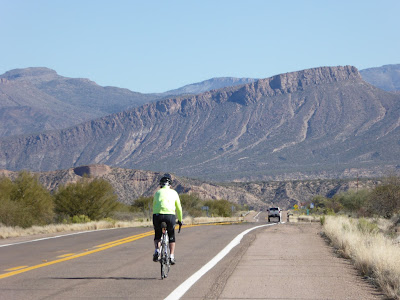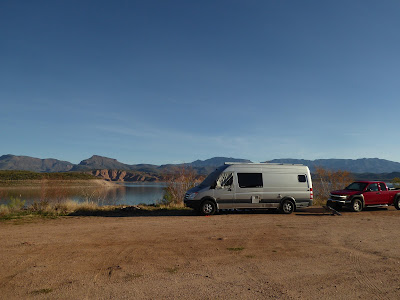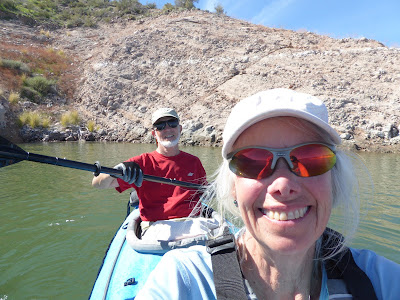What we do for a month at Roosevelt Lake, Arizona. January 22 to Feb 17.
When January sinks into the doldrums of snow and cold we head for warmer climes at our nearest retreat, Roosevelt Lake. We decided to spend a month at the lake in one of the Tonto National Forest campgrounds in the desert hills above the shore.
Our camp is at Coati Loop in Windy Hill, a Tonto National Forest campground. The campground has paved interior roads, restrooms with flush toilets and solar heated showers. There are walk-in tent sites to give tenters privacy. All camp sites have a shaded picnic table and metal fire pit. There are double sites for people recreating together.Water is available at taps in several locations. Two dump stations are located at the Cholla Campground north of the dam and are only open 4 days a week for some odd reason.
The Tonto is in the process of converting from daily passes purchased at area business and the visitor center to automated check-in kiosks at each campground. You'll have to call the visitor center to get current info on rates.
 |
| The view from our camp site at Roosevelt Lake looking across the lake to the Sierra Ancha Mountains. |
From our camp site we can look across Roosevelt Lake to the Sierra Ancha Mountains in the east.
 |
| Our site at Coati Loop in Windy Hill Campground at Roosevelt Lake in the Tonto National Forest. |
 |
| Sunrise at Roosevelt Lake. |
 |
| Sunrise at Roosevelt Lake. |
We like Roosevelt Lake for all the recreation options. We brought our pickup with us this time so we could access trails and boat ramps we couldn't get to with the Sprinter. Each day is a new adventure. Here are some of the things we did.
Hiking Tule Trail 122. Be prepared for a steep hike into the Superstition Wilderness. The first few miles were easy as the trail meanders along the foothills but then climbs steeply to a ridge for about two miles to the junction with the Two Bar Trail which is part of the Arizona Trail system. Our 9+ mile hike had an elevation gain is about 1800 ft. and spectacular mountain views in every direction.
 |
| Taking a rest break near the top of the climb about half a mile before we reached the Two Bar Trail. |
 |
| The Tule Trail takes us high into the Superstition Mountains. |
 |
| A view of Roosevelt Lake from the top of the Tule Trail. |
 |
| At the junction of the Tule and Two Bar Trails. |
 |
| The signs tell you where you are but not how far you have to go. |
Kayaking Apache Lake. It's a short drive from our camp to the Burnt Corral Campground and boat ramp on Apache Lake just below Roosevelt Dam. This is a great lake to paddle. It's not as big as Roosevelt but the shore has more bird habitat.
 |
| Ready to launch our inflatable kayak. |
We choose to buy an Advanced Elements inflatable kayak because it could be folded into a large suitcase-size bag that fit easily into the storage compartment below the bunk of our Sprinter. It's a 15 ft. tandem with seats that can be configured for one person. It only takes about 15 minutes to set up. We've been very pleased with it.
 |
| Out on Apache Lake. |
 |
| We land on a beach for a break and snacks. |
 |
| Apache Lake has many bays and reeds that provide good bird habitat. |
 |
| A Great Blue Heron stalks the shoreline. We also saw Eared Grebes. |
Hiking to Workman Falls and McFadden Lookout in the Sierra Ancha Mountains. We went with friends up into the Sierra Ancha's on the east side of Roosevelt Lake to see the waterfall in Workman Creek. Recent snows covered the higher elevations so we took a snow hike.
 |
| We take a snow hike to Workman Falls. |
The cliff at the falls was draped with icicles. Notice the icy cone the water formed at the bottom of the falls.
 |
| The water formed an icy cone at the bottom of the falls. |
After our hike to the falls we hiked a few miles to the McFadden Lookout Tower to catch the view.
 |
| Cissy and Jim at the McFadden Lookout. |
 |
| The view of the Sierra Ancha Mountains from the lookout. |
Hiking The Jug Trail. It was about a 40 mile drive to the trailhead on the east side of the lake and takes about 1.5 hours to drive there. This is only a 4-mile hike but the big reward is a destination called The Jug. The trail starts at the A Cross Trailhead on top of a ridge and descends about 800 ft. into a canyon. It's an easy grade on an old service road that is now open only to hiking.
 |
| Looking into Salome Creek toward Roosevelt Lake. |
 |
| Dutch Woman Butte sites like a fortress guarding Salome Creek and The Jug. |
 |
| Salome Creek as it flows into The Jug. There's a good runoff from recent snow. |
 |
| Salome Creek splashes it's way to The Jug. |
 |
| The Jug deepens and falls |
The Jug is a well known canyoneering route. It's short and wet and probably best done on a hot day. The creek is running high with snow melt and the water icy cold.
 |
| Water tumbles into The Jug. |
 |
The only view into the depths of The Jug unless you plan on canyoneering down it.
Many waterfall await the canyoneer. |
 |
| The Jug in black & white. |
Hiking Trail 117 to Reavis Gap. We drove forest road 499A to the Campaign Trailhead. Four-wheel drive is necessary to get to the trailhead. After hiking up the Campaign Trail 256 for a mile we took trail 117 up the mountain to the junction with Two Bar Trail 119 at Reavis Gap in the Superstition Wilderness. The trail is often rocky as it ascends into the rough country.
 |
| Hiking up Campaign Creek on trail 256. |
 |
| At Reavis Gap. |
 |
| The mountain peaks are crowned with jagged spires. |
 |
| A nice view of the Four Peaks. |
A solitude as immense as the country is one of the rewards when hiking in the Superstition Wilderness away from the popular main trails. The only sound are the delicate single-note calls of the many Phainopepla that perch in the scrubby treetops on sun-warmed slopes. The single sweet note is all the Phaino needs to say everything he wants to say.
 |
| A Phainopepla calls with a single sweet note. |
 |
| Jim at the junction of trails 117 and 119 at Reavis Gap. |
This hike was an 8-mile round trip with 1600 feet elevation gain. We took a break partway up the climb and sat next to the remains of a prickly pear cactus. The skin had fallen away leaving intricate structures within structures that look much like the cactus pad. Nature is amazing in detail.
 |
| The interior structure of a Prickly Pear Cactus pad. |
Bicycling Highway 188. Our favorite road ride at Roosevelt is going south towards Globe on 188. From Windy Hill Campground to the pass going south it's a 29-mile ride with a 1600 foot altitude gain in the last 6 miles on a 6% grade. The nice thing about the ride is that the grade is uniform all the way to the top. In the middle of the photo below you can see the road cuts as the highway ascends to the pass.
 |
| Highway 188 ascends to the pass between Roosevelt Lake and Globe, AZ |
 |
| Jim riding down the highway on the way to the pass. |
It took us 41 minutes to climb the 6 miles to the top of the pass and 12 minutes to descend to the same spot. The reward for the day, to go very fast on a bike.
 |
| Jackie at the top of the pass. |
For Birders. The Sonoran vegetation in the campground is home to a variety of birds. We have Gambel's Quail calling all through the day as they wander through the camp. We've also seen White-crowned Sparrow, Black-throated Sparrow, Flicker, Gila Woodpecker, Cactus Wren, Dusky Flycatcher, Cactus Wren, Cardinal, Curved-bill Thrasher, Red-tailed Hawk, Coopers Hawk, Raven and Roadrunner. On the lake are Western Grebe, Eared Grebe, Great Blue Heron, Osprey, Bald Eagle, Gulls, Redhead, Coot and other waterfowl. The bird species aren't as numerous as they are in March when the migrations begin.
 |
| White-crowned Sparrows at our campsite. |
 |
| A Phainopepla at our campsite. |
 |
| Phainopeplas are very numerous here. |
Kayak Fishing. Our friend, Dave, wants to try fishing from a our kayak so we go to Apache Lake and spend the day. I provide the power. The fish didn't cooperate to complete the experience even though it was catch and release.
 |
| Kayak fishing on Apache Lake. |
 |
| We paddle the kayak into the little bays along the lake. |
Hiking to Hell's Hole. Trail 284 on the west side of Roosevelt Lake in the Sierra Ancha Mountains, leads into the Salome Wilderness. We hiked 14 miles and had a total elevation gain of over 4000 ft. The last mile of the trail drops steeply into Hell's Hole. This section of trail is overgrown and hasn't been maintained for some time. Not a great trail for a hot day. When we got to the bottom Workman Creek, which flows through the Hole, was running high and we decided not to cross it so we didn't hike on down canyon to the actual hole. It's supposed to have some nice waterfalls and plunge pools. Guess we'll save it for another day.
 |
| Part way down the decent into Workman Creek. |
 |
| Workman Creek above Hell's Hole. |
 |
| Jim hiking up the trail out of Workman Creek. |
We moved our camp from the Coati Loop at Windy Hill to the Roosevelt Lake Marina for the last three days of our stay. It's just a bare parking lot with about 6 stone fire rings to show where the campsites should be. There are 4 portapotties and a boat ramp. The fee is $6 per night or $3 with the senior pass. It's a no frills campground but the view of the lake is wonderful and we can just walk our kayak to the boat ramp.
 |
| Our campsite at Roosevelt Lake Marina. |
 |
| A nice view of Roosevelt Lake from our camp. |
We set up our kayak and take off across the lake for a wonderful afternoon of paddling. Temperatures were in the upper 60's with bountiful sunshine and no wind. Perfection.
 |
| Kayaking across Roosevelt Lake. |
 |
| Paddling along the shore. |
 |
| A view of the bridge at the dam as we paddle across the lake. |
 |
| Sailboats on the lake. |
 |
| A peaceful sunset after our day on the lake. |
 |
| Jim salutes the Big Saguaro. |
A Big Saguaro. We could just see a clump of Saguaro tops from the road. When we got over to it we found one really Big Saguaro. It has six trunks and too many arms to count. It's the grand daddy of Saguaros.
 |
| Jim and the Big Saguaro. |
 |
| Six trunks seem to come out of the same root. |
 |
| Saguaro arms grow in every direction. |
Pinto Creek Hike. From Highway 188 we turn onto Forest Road 242 at the south end of Roosevelt Lake and descent into Pinto Creek. 4-wheel drive is a must. The Cottonwoods are bare in February which makes it easier to pick a route through the brush going down canyon to the narrows. It's only about a mile but the going is slow.
 |
| Hiking down Pinto Creek. |
There's lots of evidence of a flash flood that left matted debris stacked against the tree trunks.
 |
| The creek runs through a maze of boulders. |
As we get closer to the narrows the stream becomes choked with large boulders we have to work our way around.
 |
| We put on kayaking shoes and wade into the narrows. |
When we get to the narrows the stream flows wall to wall.We put on our kayaking shoes and leave our boots behind.
 |
| Entering the narrows of Pinto Creek. |
 |
| A Polar Bear Jacuzzi. |
 |
| Jim walking down through the cool shadows of the narrows. |
 |
| Colorful cliff walls in the narrows. |
We get near the lower end of the narrows and our way is blocked by boulders to big to climb back up and a creek too deep to wade and too cold to swim on this February day.
 |
| A nice deep swimming hole for a hot day in June. |
We turn around at a deep pool between the boulders and head back up canyon.
 |
| Neoprene socks and kayaking shoes make a great combination for wading in the cold water. |
 |
| The pool were we turned around. |
A section of the creek bed is made of travertine.
 |
| Travertine creek bed. |
 |
| Pools of light. |
 |
| Rock draperies. |
Above the creek desert vegetation hangs on rock ledges.
 |
| A hanging garden on the cliff wall. |
We've spent three weeks exploring Roosevelt Lake and the Tonto National Forest. On our last night we have the Marina Campground all to ourselves and enjoy the serenity of the lake. Wish we had time to put our kayak on the lake.
 |
| Sunset at Roosevelt Lake from our campsite at the Roosevelt Lake Marina. |
 |
| The lake is like glass. Only the calls of gulls and water birds carries across the still water. |
So, to sum it up, in our 3 weeks at Roosevelt we did 51 miles of rough desert mountain hiking, 162 miles of biking lightly used roads, and a total of 5.75 hours in the kayak. Far more than we could accomplish by staying home.
Our next post will be about a hike to Devil's Chasm which we didn't include in this post. We'll visit Devil's Chasm Fortress.
Until next time.
Jackie